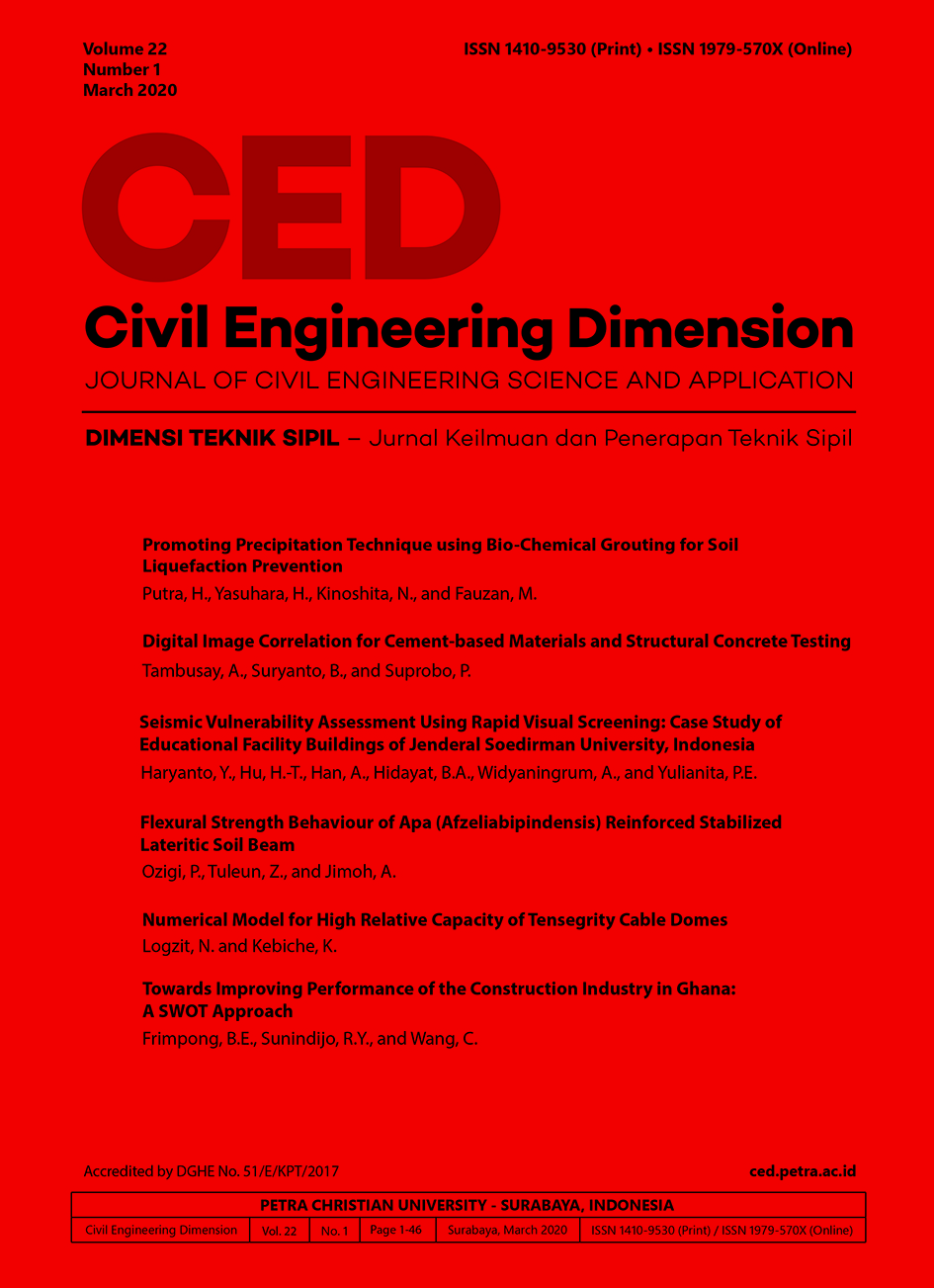Flexural Strength Behaviour of Apa (Afzeliabipindensis) Reinforced Stabilized Lateritic Soil Beam
DOI:
https://doi.org/10.9744/ced.22.1.22-28Keywords:
Lateritic soil, Apa (Afzeliabipindensis) reinforced soil beam, flexural strengthAbstract
This paper reports on the flexural strength behaviour of Apa reinforced stabilized lateritic soil beams. The potential of using timber as a reinforcement material is because timber is abundant, cheap and locally available compared to conventional steel. Apa timber possess a tensile strength of 68.34 N/mm2. Experimental and Finite Element Analysis using ANSYS 15 were carried out to determine the flexural strength of Apa reinforced lateritic soil beams. The results showed an increase in the load-bearing capacity with increase in the percentage area of Apa reinforcement used in Lateritic soil beams. BS 8110-1:1997 requires that area of reinforcement for beams should not exceed 4%. At 4 percent area, the flexural strength of the Apa reinforced lateritic soil beams (ALB) was 0.763 N/mm2 with corresponding load capacity of 3.435 kN which is slightly higher than the steel reinforced lateritic soil beams (SLB) of 0.740 N/mm2 with corresponding load capacity of 3.329 kN obtained in the reportReferences
Thagesen, B., Tropical Rocks and Soils, in: Highway and Traffic Engineering in Developing Countries, London: ed. Chapman and Hall, 1996.
Lambe, T. W. and Whitman, V. R., Soil Mechanics, New York: diversion John Wiley and Sons Inc, 1979.
Kaze, R.C., Microstructure and Engineering Properties of Fe2O3 (FeO)-Al2O3-SiO2 based Polymer Composite, Journal of Cleaner Production, 199(1), 2018, pp. 849-859.
NCP 2., Nigerian Standard Code of Practice; The Use of Timber for Construction, Lagos: Nigerian Standards Organisation, Federal Ministries of Industries, 1973.
Jimoh, A.A., Rahmon, R.O., and Joseph, S.G., Evaluation of Compressive Strength Characteristics of Structural-sized Apa (Afzelia bipinden¬sis) and Opon (Lannea schimperi) Timber Species Columns found in Nigeria, Journal of Applied Sciences and Environmental Management (JASEM). 21(7), 2017, pp. 1281-1285.
Aguwa, J. I., Reliability Assessment of the Nigerian Apa (Afzelia Bipindensis) Timber Bridge Beam Subjected to Bending and Deflection Under the Ultimate Limit State of Loading, International Journal of Engineering and Technology (IJET), 2(6), 2012, pp. 1076-1088.
Ozigi, P.B., Jimoh, A.A., Rahmon, R.O., and Babatunde, O.Y., Investigation on some Physical and Mechanical Properties of Apa (Afzelia Bipindensis) Timber grown in Kwara State, Nigeria, USEP: Journal of Research Information in Civil Engineering, 15(1), 2017, pp. 2027-2044.
Richard, A.S., Manette, N., Kallenama, A.K., and James, A., Experimental Behaviour of Reinforced Sugarcane Bagasse Ash Laterised Concrete Beam without Shear Reinforcement, International Journal of Civil and Environmental Research, 4(1), 2014, pp. 133-140.
Graeme, N., Earth as a Building Material,Waltakere City Council’s Sustainable Home Guidelines, 2008
BS EN 12390-5., Testing Hardened Concrete. Flexural Strength of Test Specimens, London: British Standard Institution, 2000.
BS 1377: Part 2, Soils for Civil Engineering Purposes, London: British Standard Institution, 1990.
BS 373. Methods of Testing Small Clear Specimens of Timbers, London: British Standard Institution, 1957.
BS 1881-116, Method for Determination of Compressive Strength of Concrete Cubes, London: British Standards Institution., 1983
Neville, A.M., Properties of Concrete, Fifth Edition, 2234–2236, 2011.
AASHTO (1986), Standard Specifications for Transportation Materials and Method of Testing and Sampling, American Association of State Highway and Transportation Officials, Washington D.C., U.S.A.
Sackey, K. A., An Evaluation of the Characteristics of Stabilized Poured Laterite Beams Reinforced with Polypropylene Rope, MSc. Thesis, Ahmadu Bello University, Department of Building, Zaria, 2015.
BS 8110-1, Structural Use of Concrete, Code of Practice for Design and Construction, Part 1, British Standards Institution, London, United Kingdom, 1997.
Downloads
Published
How to Cite
Issue
Section
License
Authors who publish with this journal agree to the following terms:- Authors retain the copyright and publishing right, and grant the journal right of first publication with the work simultaneously licensed under a Creative Commons Attribution License that allows others to share the work with an acknowledgement of the work's authorship and initial publication in this journal.
- Authors are able to enter into separate, additional contractual arrangements for the non-exclusive distribution of the journal's published version of the work (e.g., post it to an institutional repository or publish it in a book), with an acknowledgement of its initial publication in this journal.
- Authors are permitted and encouraged to post their work online (e.g., in institutional repositories or on their website) followingthe publication of the article, as it can lead to productive exchanges, as well as earlier and greater citation of published work (See The Effect of Open Access).











